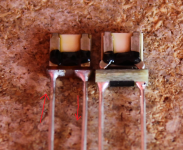Hi folks,
Is there anyone here who has tried to find the signal direction of the common types of Z-foil resistors (TX2575, Charcroft CAR, Z201) with reference to the resistive layer (nude types) or printed text 'Z201' (encapsulated type)? Left to right or right to left?
I have my own observations, but will share them at a later stage in order not to affect on your opinion.
Is there anyone here who has tried to find the signal direction of the common types of Z-foil resistors (TX2575, Charcroft CAR, Z201) with reference to the resistive layer (nude types) or printed text 'Z201' (encapsulated type)? Left to right or right to left?
I have my own observations, but will share them at a later stage in order not to affect on your opinion.
Z-foils are individually laser trimmed and we have no way of knowing how many of the shorting strips have actually been removed in a specifc resistor and at which positions along the foil. Since the trimming is the only possibly asymmetry found in Z-foils (otherwise the are of 100% symmetric construction) all bets are off that there could be a strategically better general orientation (that is, if you actually believe in such a thing, and even if when you do -- but remember audio is an AC signal -- then it would be circuit specific, so no generalized statements could be made).
You are asking people if they have found something which does not exist. What is the point of this?
Even if these resistors were significantly asymmetric then which way the 'signal flows' would not be relevant; it would be which way the DC flows which would matter.
You are talking about "believing", but believing something which is not true.
Even if these resistors were significantly asymmetric then which way the 'signal flows' would not be relevant; it would be which way the DC flows which would matter.
You are talking about "believing", but believing something which is not true.
Sorry to disappoint you, but no one involved in the production process of these resistors cares about the orientation of the resistive element, it is completely random. Just like all those people who 'hear' the orientation of components they identify by the printing on it, its purely imagination.
Regards,
Rundmaus
EDIT: In different words: You are claiming that the resistive element does not determine the components influence on the 'sound', but a small dot of black gunk is what matters. Sounds strange to me.
Regards,
Rundmaus
EDIT: In different words: You are claiming that the resistive element does not determine the components influence on the 'sound', but a small dot of black gunk is what matters. Sounds strange to me.
Last edited:
Vishay TX2575 and Charcroft Z-Foil are different but they all has the same direction . I am using them as I/V as on the picture it is clearly audible and easy to catch. Left one is the Vishay TX2575 .
If I change + and - on my speakers, do I have to change the direction of the resistor in order to get good sound?
//
One pin of a resistor always has larger AC audio signal than the other, so in theory orientation does make sense. I am more interested in the physics behind it, if there is any. If there is no physics behind it, this is the territory of psychology.... remember audio is an AC signal ...
If I change + and - on my speakers, do I have to change the direction of the resistor in order to get good sound?
No, providing you are doing a handstand to compensate for the phase rotation
Last edited:
The Bulgarians have golden ears 
I was just trying to figure out if it was an information direction or electrical potential aspect that was believed to be in play. The answer seem to be "electrical" so the AC signal argument would be valid. The pins voltage potential "variate" - sometimes pin 1 is higher, sometimes it's lower than pin 2 That is what AC really is. Music is AC.
That is what AC really is. Music is AC.
If any of you golden ears also happened to have some electrical engineering skills, could you please describe what is really happening here?
//
I was just trying to figure out if it was an information direction or electrical potential aspect that was believed to be in play. The answer seem to be "electrical" so the AC signal argument would be valid. The pins voltage potential "variate" - sometimes pin 1 is higher, sometimes it's lower than pin 2
If any of you golden ears also happened to have some electrical engineering skills, could you please describe what is really happening here?
//
What is happening here: People need some visible property of their stuff, like direction of markings on components, thickness of speaker wires and so on which they can influence or change, believing that this changes the sound. The rest happens in the mind (willing to believe).
Regards,
Rundmaus
Regards,
Rundmaus
- Status
- This old topic is closed. If you want to reopen this topic, contact a moderator using the "Report Post" button.
- Home
- Design & Build
- Parts
- Signal direction of bulk Z-foil resistors
